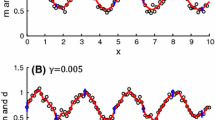Abstract
In this paper, the linear and nonlinear leastsquares methods are developed in matrix notation as solution schemes to determine key parameters from whole-field fringe patterns. Examples of the proposed methods to the determination of the photoelastic-fringe constant from a disk in diametral compression and the opening-mode geometric stress-intensity factor from the photoelastic-fringe loops in the neighborhood of a crack tip are presented. In the latter example, the location of the crack tip is treated as an unknown to be determined from the analysis.
Similar content being viewed by others
Abbreviations
- r, θ:
-
polar coordinates
- x, y :
-
Cartesian coordinates
- R :
-
radius of circular disk
- N :
-
photoelastic-fringe oder
- f o :
-
photoelastic-fringe constant
- t :
-
model thickness
- A, B, C :
-
constants
- P :
-
magnitude of a point load
- K 1 :
-
opening-mode stress-intensity factor
- σ 0x :
-
nonsingular, far-field stress
- a :
-
crack length
- W :
-
plate width
- x 0 , y 0 :
-
location of crack tip
References
Kobayashi, A.S., Experimental Techniques in Fracture Mechanics,2,Soc. for Exp. Stress Analysis,Westport, CT (1975).
Mueller, R.K., “Mathematical and Physical Modelsr”Experimental Mechanics,18 (7),241–245 (July 1978).
Coker, E.G. andFilon, L.N.G., A Treatise on Photoelasticity, 2nd Ed., University Press, Cambridge (1957).
Durelli, A.J. andMulzet, A.P., “Large Strain Analysis and Stresses in Linear Materials,”J. Engineering Mechanics Div., ASCE,91,No. EM3,65–91 (June 1965).
Frocht, M.M., Photoelasticity,II,John Wiley,New York,136 (1948).
Redner, A.S., “Experimental Determination of Stress Intensity Factors—A Review of Photoelastic Approaches,” Fracture Mechanics and Technology, Noordhoff International (1978).
Etheridge, J.M. andDally, J.W., “A Critical Review of Methods for Determining Stress-Intensity Factors from Isochromatic Patterns,”Experimental Mechanics,17 (7),248–254 (July 1977).
Sanford, R.J. andDally, J.W., “A General Method for Determining Mixed-Mode Stress Intensity Factors from Isochromatic Fringe Patterns,”Engineering Fracture Mechanics,11 (4),621–633 (1979).
Irwin, G.R., “Discussion of: The Dynamic Stress Distribution Surrounding a Running Crack—A Photoelastic Analysis,”Proc. SESA,16 (1),93–96 (1958).
Irwin, G.R., Dally, J.W., Kobayashi, T. and Etheridge, J.M., “A Photoelastic Study of the Dynamic Fracture Behavior of Homalite 100,” NUREG-75/107, University of Maryland (Sept. 1975).
Etheridge, J.M. andDally, J.W., “A Three-Parameter Method for Determining Stress Intensity Factors from Isochromatic Fringe Patterns,”J. of Strain Analysis,13 (2),91–94 (1978).
Beinert, J., “Experimental Methods in Dynamic Stress Analysis,” IUTAM Symposium—Modern Problems in Elastic Wave Propagation, Evanston, IL (Sept. 1977).
Author information
Authors and Affiliations
Rights and permissions
About this article
Cite this article
Sanford, R.J. Application of the least-squares method to photoelastic analysis. Experimental Mechanics 20, 192–197 (1980). https://doi.org/10.1007/BF02327598
Received:
Revised:
Issue Date:
DOI: https://doi.org/10.1007/BF02327598




